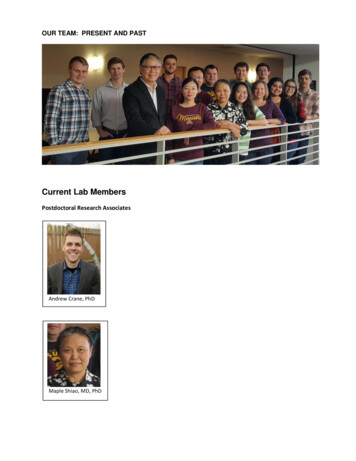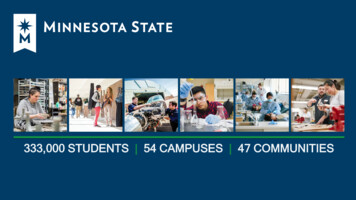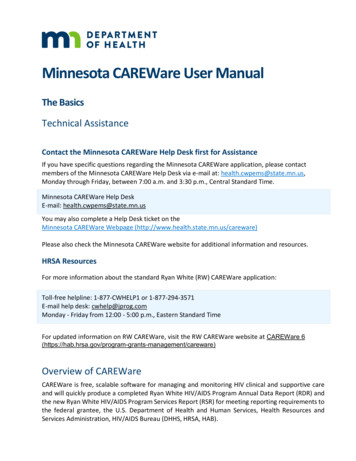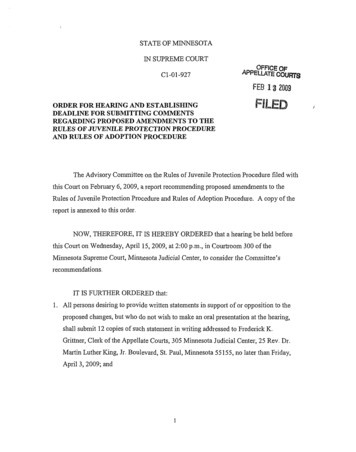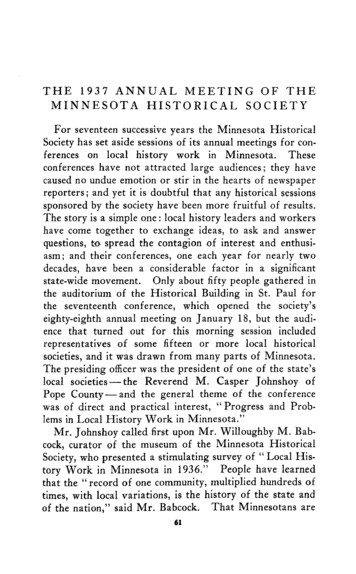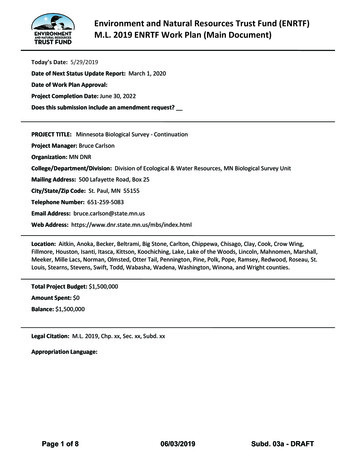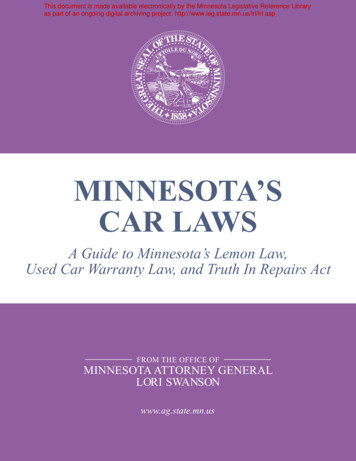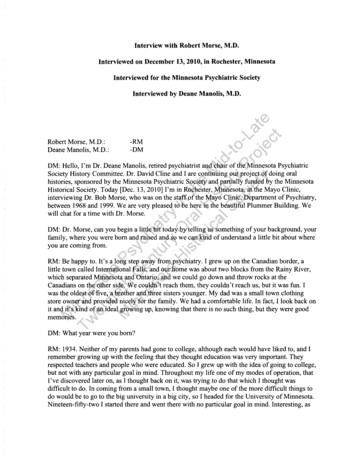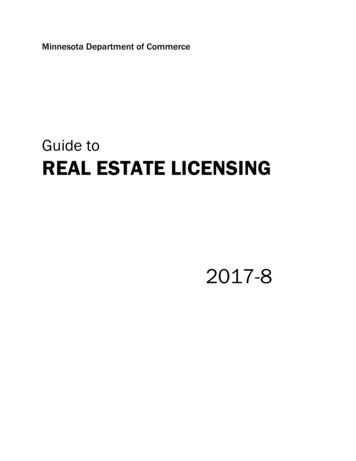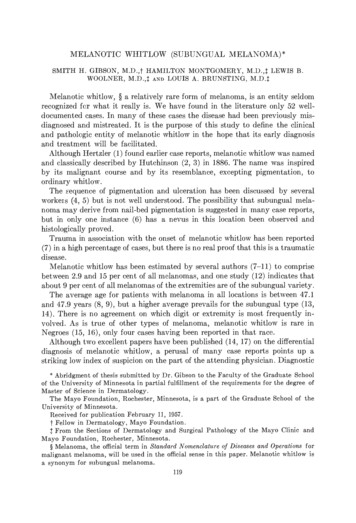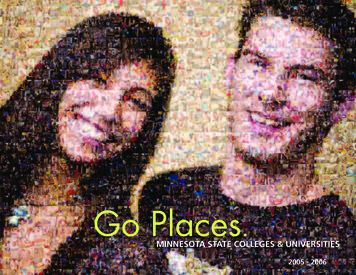
Transcription
Go Places.MINNESOTA STATE COLLEGES & UNIVERSITIES2005 - 2006
2yrPlease call. We’d like to talk with you. Check out our Web sites, too.State CollegesALEXANDRIA TECHNICAL COLLEGE . . . . . . . . . . . . . . . . www.alextech.eduAlexandriaToll-free: 1-888-234-1222ANOKA-RAMSEY COMMUNITY COLLEGE . . . . . . . . . . . . www.anokaramsey.eduCambridge, Coon Rapids(763) 422-3333ANOKA TECHNICAL COLLEGE . . . . . . . . . . . . . . . . . . . . . www.anokatech.eduAnoka(763) 576-4850CENTRAL LAKES COLLEGE . . . . . . . . . . . . . . . . . . . . . . . www.clcmn.eduBrainerd, StaplesToll-free: 1-800-933-0346CENTURY COLLEGE. . . . . . . . . . . . . . . . . . . . . . . . . . . . . www.century.eduWhite Bear LakeToll-free: 1-800-228-1978DAKOTA COUNTY TECHNICAL COLLEGE . . . . . . . . . . . . . www.dctc.eduRosemountToll-free: 1-877-937-3282, x020FOND DU LAC TRIBAL & COMMUNITY COLLEGE . . . . . . . www.fdltcc.eduCloquetToll-free: 1-800-657-3712HENNEPIN TECHNICAL COLLEGE . . . . . . . . . . . . . . . . . . . www.hennepintech.eduBrooklyn Park, Eden PrairieToll-free: 1-800-345-4655INVER HILLS COMMUNITY COLLEGE . . . . . . . . . . . . . . . . www.inverhills.eduInver Grove Heights(651) 450-8500LAKE SUPERIOR COLLEGE . . . . . . . . . . . . . . . . . . . . . . . www.lsc.eduDuluthToll-free: 1-800-432-2884MINNEAPOLIS COMMUNITY & TECHNICAL COLLEGE. . . . www.minneapolis.eduMinneapolisToll-free: 1-800-247-0911MINNESOTA STATE COLLEGE - SOUTHEAST TECHNICAL. . www.southeastmn.eduRed Wing, WinonaToll-free: 1-877-853-8324MINNESOTA STATE COMMUNITY & TECHNICAL COLLEGE . . www.minnesota.eduDetroit Lakes, Fergus Falls, Moorhead, WadenaToll-free: 1-888-MY MSCTC (696-7282)NORTH HENNEPIN COMMUNITY COLLEGE . . . . . . . . . . . www.nhcc.eduBrooklyn ParkToll-free: 1-800-818-0395NE - HIBBING COMMUNITY COLLEGE* . . . . . . . . . . . . . . www.hcc.mnscu.eduHibbingToll-free: 1-800-224-4422NE - ITASCA COMMUNITY COLLEGE* . . . . . . . . . . . . . . . www.itascacc.eduGrand RapidsToll-free: 1-800-996-6422NE - MESABI RANGE COMMUNITY & TECHNICAL COLLEGE* www.mr.mnscu.eduEveleth, VirginiaToll-free: 1-800-657-3860NE - RAINY RIVER COMMUNITY COLLEGE* . . . . . . . . . . . www.rrcc.mnscu.eduInternational FallsToll-free: 1-800-456-3996NE - VERMILION COMMUNITY COLLEGE* . . . . . . . . . . . . www.vcc.eduElyToll-free: 1-800-657-3608NORTHLAND COMMUNITY & TECHNICAL COLLEGE . . . . . www.northlandcollege.eduEast Grand Forks, Thief River FallsToll-free: 1-800-959-NCTC (6282)NORTHWEST TECHNICAL COLLEGE** . . . . . . . . . . . . . . . www.ntcmn.eduBemidjiToll-free: 1-800-942-8324PINE TECHNICAL COLLEGE . . . . . . . . . . . . . . . . . . . . . . . www.pinetech.eduPine CityToll-free: 1-800-521-7463RIDGEWATER COLLEGE. . . . . . . . . . . . . . . . . . . . . . . . . . www.ridgewater.eduHutchinson, WillmarToll-free: 1-800-722-1151RIVERLAND COMMUNITY COLLEGE . . . . . . . . . . . . . . . . www.riverland.eduAlbert Lea, AustinToll-free: 1-800-247-5039ROCHESTER COMMUNITY AND TECHNICAL COLLEGE . . . www.rctc.eduRochesterToll-free: 1-800-247-1296ST. CLOUD TECHNICAL COLLEGE . . . . . . . . . . . . . . . . . . . www.sctc.eduSt. CloudToll-free: 1-800-222-1009SAINT PAUL COLLEGE. . . . . . . . . . . . . . . . . . . . . . . . . . . www.saintpaul.eduSt. PaulToll-free: 1-800-227-6029MINNESOTA WEST COMMUNITY & TECHNICAL COLLEGE . . www.mnwest.eduCanby, Granite Falls, Jackson, Pipestone,Toll-free: 1-800-658-2330WorthingtonSOUTH CENTRAL COLLEGE . . . . . . . . . . . . . . . . . . . . . . . www.southcentral.eduFaribault, MankatoToll-free: 1-800-722-9359NORMANDALE COMMUNITY COLLEGE . . . . . . . . . . . . . . www.normandale.eduBloomingtonToll-free: 1-866-880-8740*NE stands for Northeast Higher Education District, a consortium made up of five state colleges:Hibbing, Itasca, Mesabi Range, Rainy River and Vermilion.**Northwest Technical College is aligned with Bemidji State University.4yrState UniversitiesBEMIDJI STATE UNIVERSITY . . . . . . . . . . . . . . . . . . . . . . www.bemidjistate.eduBemidjiToll-free: 1-877-BEMIDJI (236-4354)METROPOLITAN STATE UNIVERSITY . . . . . . . . . . . . . . . . www.metrostate.eduSt. Paul, Minneapolis(651) 793-1300MINNESOTA STATE UNIVERSITY, MANKATO . . . . . . . . . . www.mnsu.eduMankatoToll-free: 1-800-722-0544MINNESOTA STATE UNIVERSITY MOORHEAD . . . . . . . . . www.mnstate.eduMoorheadToll-free: 1-800-593-7246ST. CLOUD STATE UNIVERSITY . . . . . . . . . . . . . . . . . . . . www.stcloudstate.eduSt. CloudToll-free: 1-877-654-7278SOUTHWEST MINNESOTA STATE UNIVERSITY . . . . . . . . . www.southwestmsu.eduMarshallToll-free: 1-800-642-0684WINONA STATE UNIVERSITY. . . . . . . . . . . . . . . . . . . . . . www.winona.eduWinonaToll-free: 1-800-DIAL-WSU (342-5978)The University of Minnesota is not a part of the Minnesota State Colleges and Universities system.For U of M information, contact (612) 625-2008 or www.umn.edu .
MINNESOTAState Colleges & UniversitiesNE-Rainy RiverCommunity CollegeFind your future hereInternational FallsNorthland Community &Technical College Our seven state universities and 25two-year community and technicalcolleges are located throughout thestate.Thief River FallsNE-VermilionCommunity CollegeNorthland Community &Technical CollegeElyEast Grand ForksNE-Mesabi Range Community& Technical CollegeVirginiaBemidji State UniversityNorthwest Technical CollegeBemidjiNE-Mesabi Range Community& Technical CollegeNE-HibbingCommunityCollege More than 86 percent of ourgraduates get jobs related to theirfield of study.EvelethNE-Itasca Community CollegeGrand RapidsLake Superior CollegeMinnesota State University MoorheadMinnesota StateMinnesota StateCommunity &Community & TechnicalTechnicalCollegeCollegeDetroit LakesDuluthCloquetCentral LakesCollegeCentral LakesStaplesCollegeBrainerdPine Technical CollegeFergus FallsPine CityWillmarRidgewaterCollegeHennepinTechnical CollegeHutchinsonEden PrairieMinnesota WestCommunity &Technical CollegeBloomingtonCanbySouthwest MinnesotaState UniversityMarshallSouth Central CollegeMinnesota State College–Southeast TechnicalSouth Central CollegeWorthingtonRosemountInver HillsCommunity CollegeInver Grove HeightsMinnesota State Collegesand Universitieswww.mnscu.eduTwin Cities:(651) 296-8012Toll-free:1-888-MnSCU-4-U (667-2848)TTY:(651) 282-2660FaribaultMinnesota State College–Southeast TechnicalWinonaRochesterCommunityWinona State& Technical CollegeUniversityMinnesota StateUniversity, MankatoMinnesota WestCommunity &Technical CollegeMinnesota WestCommunity &Technical CollegeDakota CountyTechnical CollegeRed WingNorth MankatoPipestoneCoon RapidsNormandaleCommunity College Our colleges and universitieseducate 78 percent of Minnesota’snew nursing graduates, more thanhalf of the state’s new teachinggraduates and 92 percent of thestate’s law enforcement officers. We provide a top-notch education ata reasonable price.Anoka-RamseyCommunity CollegeNorth HennepinHennepinSt. Cloud Technical College Technical CollegeCommunity CollegeBrooklyn ParkBrooklynParkCentury CollegeSt. Cloud StateAnoka-RamseyWhite Bear LakeUniversityMetropolitanCommunity CollegeState UniversityCambridgeMinneapolisMinneapolisCommunity &MetropolitanTechnical CollegeState UniversitySt. PaulSaint PaulCollegeRidgewater CollegeGranite FallsAnoka TechnicalCollegeAnokaAlexandriaTechnical CollegeMinnesota West Community& Technical College4-year State Universities2-year State CollegesFond du Lac Tribal &Community CollegeMoorheadMinnesota StateCommunity &Technical CollegeWadenaMinnesota StateCommunity &Technical CollegeLOCATION, LOCATION, LOCATIONMore choices. Better value.Unlimited possibilities.Minnesota WestCommunity &Technical CollegeJacksonRiverlandCommunityCollegeRiverland Community CollegeAustinAlbert Lea1
GETTING STARTEDStart early to get ready for collegeCollege planning checklistStart early. Aim high. During high school, take courses that willmeet entrance requirements at the college or university youwish to attend. If you are uncertain which college or universityyou want to attend, talk to your high school counselor. Use thischecklist to help you stay on track.9th and 10th grades m Take classes that prepare you to continue youreducation after high school. Nearly all interesting andwell-paying jobs require some formal education beyondhigh school. At least three years each of mathematics,English, science and social studies are recommended.Your high school counselor can help you choose the bestcourses.Campus coffee shops are popular.Decide what kind of college or universityis right for youTechnical colleges are two-year state colleges that teach knowledge andskills leading to specific careers.Community colleges are two-year state colleges that enable you to start ona bachelor’s degree. You can take your first two years of college at acommunity college and then transfer to a four-year college or university tocomplete your degree. Community colleges also offer career programs leadingdirectly to a job.Combined community and technical colleges offer technical andcommunity college programs. You can start on a bachelor’s degree andtransfer after two years, just like you can at a community college. Or you canenroll in a technical program to learn skills that lead directly to a career, justlike you can at a technical college.State universities are four-year institutions offering courses and programsleading to bachelor’s, master’s and advanced degrees. Most offer on-campushousing in residence halls and a full range of student activities.2m Plan ahead and visit your school career center orcounseling office to explore resources, including careerguides and brochures from colleges and universities.By 11th gradem Request information from colleges and universities thatinterest you. Visit college and university Web sites. Call theadmissions offices and ask them to send you a brochure,mail in the reply card in this book or ask for informationonline php .m Schedule campus visits by calling admissions offices atseveral colleges or universities this year or in the fall ofyour senior year. See “Tips for campus visits” on Page 4.m Take a standardized college entrance test if you thinkyou may want to start at a four-year university. Check withyour high school counselor about the test schedule andwhich test—either the ACT or SAT test—is required foradmission at the college or university you want to attend.Check out www.mnscu.edu
Earn college credits during high schoolGETTING STARTEDThousands of high school juniors and seniors earn college credit at theMinnesota State Colleges and Universities by participating in thestate’s Post-Secondary Enrollment Options program, often called PSEO.Academically qualified students, including home school students, cantake classes at no cost to them as long as they also earn high schoolcredit.To learn more about PSEO, ask your high school counselor or contactthe admissions office at the college or university you want to attend.High school students should prepare for challenging college classes.During 12th gradem To apply to a Minnesota state college or university,fill out an application to the colleges or universities thatoffer programs, environment and location that best fityour goals.Students with disabilitiesMany students with physical and learning disabilities choose theMinnesota State Colleges and Universities. Buildings are accessible,and numerous accommodations are available to help students withdocumented disabilities succeed. Contact the disability coordinator atthe college or university you want to attend to request accommodations.You can print out an application form atwww.mnscu.edu/students/application.html, call toll-freeat 1-888-667-2848 to have one mailed to you, or fill out andreturn the postage-free reply card at the back of this book.A one-time 20 non-refundable application fee must besent with the application form to each college or universityto which you apply. Institutions may waive this fee in caseof financial need. Ask the admissions office about its policy.Apply as early as possible. Apply to a four-year university in the fall of 12th grade. Apply to a two-year college any time before the semesteryou want to begin, but applying early gives you a betterchance of getting into the programs and courses youwant.m Apply for financial aid in 12th grade, even if youhaven’t decided which college to attend. The free federalfinancial aid application is available from high schoolcounselors, college admissions offices or on the Web atwww.fafsa.ed.gov . You will be notified about yourfinancial aid eligibility. Look for scholarships, too. Collegeadmissions and financial aid offices can help you. See Page6 for more information.A student takes advantageof disabilities services asher daughter looks on.3
GETTING STARTEDFind out where you fitTips for campus visitsTips for parents and mentorsm Call and ask for an appointment totour the campus. See college anduniversity profiles (Pages 15-32 andPages 36-42) for telephone numbersto arrange a campus visit. If you areinterested in a particular academicprogram, student activity or sport, askto meet with someone in that area.m Talk about college with your studentand ask what factors would be mostimportant in picking the rightcollege.m Ask about programs and activities, aswell as tuition and other costs. Writedown your questions in advance in anotebook and take it along so youcan write down the answers.m Check out the library, computer labs,cafeterias, snack bars and bookstore.m Ask to see a dorm room if you planto live on campus. If the college hasno on-campus housing, ask aboutoff-campus options.College and universitycounselors and advisorsare a great source ofinformation and support.m Encourage your student to requestmore information. Help list thequestions that you and your studentcan ask.m Attend college fairs together, pick upbrochures and ask questions of thecollege representatives.m Help schedule campus visits. Go whenclasses are in session. Meet studentsand professors, especially in areas ofinterest, and check out residencehalls, libraries and student services aswell as academic programs.m Look around the campus andneighborhood. Can you pictureyourself there?m Find out about financial aid to helppay for college and fill out the FreeApplication for Federal Student Aid,or FAFSA form, as soon as possible in12th grade.m Congratulations! You’ve taken abig step toward choosing a campusthat’s right for you.m Have fun! You will be an excellentcoach as your student makes theseimportant plans for the future.Links to colleges and ck out www.mnscu.edu
College cost comparisonFor every dollaryou pay in tuition,the state ofMinnesota pays 1.09 to supportyour education.Out-of-state tuitionIf you live in Wisconsin, North Dakota,South Dakota or the Canadianprovince of Manitoba, you areeligible for tuition rates similar tothose paid by Minnesota residents.Several Minnesota State Collegesand Universities allow certain otherout-of-state students to pay thelower in-state rates; check with thecollege or university about its policy.Generally, out-of-state tuition isdouble the rate that Minnesotastudents pay.Room and board costsThe cost for room and board ata state university ranges from 4,688 to 5,570 for one year.Some two-year colleges also providehousing on campus or nearby, andmany others can help you findhousing in the area. The costs ofthese options will vary.2-year collegesMinnesota State Colleges 3,857Alexandria Technical College 3,582Anoka-Ramsey Community College 4,308Anoka Technical College 3,940Central Lakes College 3,903Century College 4,218Dakota County Technical College 3,975Fond du Lac Tribal & Community College 3,707Hennepin Technical College 4,179Inver Hills Community College 3,698Lake Superior College 4,028Minneapolis Community & Technical College 4,055Minnesota State College – Southeast Technical 4,223Minnesota State Community & Technical College 4,172Minnesota West Community & Technical College 3,975Normandale Community College 4,070North Hennepin Community College 3,957NE-Hibbing Community College 4,147NE-Itasca Community College 4,028NE-Mesabi Range Community & Technical College 4,178NE-Rainy River Community College 4,188NE-Vermilion Community College 4,250Northland Community & Technical College 4,170Northwest Technical College, Bemidji 3,726Pine Technical College 4,134Ridgewater College 4,109Riverland Community College 4,268Rochester Community and Technical College 3,980St. Cloud Technical College 3,791Saint Paul College 3,818South Central College 13,000 – 15,000*Dunwoody Institute 13,200Rasmussen College 14,600Aveda Institute 13,000– 15,000Minnesota School of Business/Globe 18,540Brown College*Costs vary by program.TUITION COSTSTuition at Minnesota State Collegesand Universities is lower than tuitionat many other colleges, universitiesand trade schools because the stateof Minnesota pays a portion of thecost of your education if you are astate resident.n.Annual tuition and fees, 2005-20064-year colleges and universitiesMinnesota State Universities 5,801 4,681 5,157 4,894 5,188 5,579 5,464 8,445 8,902 9,228 15,716 19,129 19,520 21,300 21,312 21,953 22,240 22,714 23,294 23,375 23,454 23,474 24,865 25,040 26,500 28,642 32,649Bemidji State UniversityMetropolitan State UniversityMinnesota State University, MankatoMinnesota State University MoorheadSt. Cloud State UniversitySouthwest Minnesota State UniversityWinona State UniversityUniversity of Minnesota, DuluthUniversity of Minnesota, Twin CitiesUniversity of Minnesota, MorrisBethany Lutheran CollegeSaint Mary’s University of Minn.Concordia College (Moorhead)Bethel CollegeConcordia University (St. Paul)Augsburg CollegeCollege of St. ScholasticaUniversity of St. CatherineUniversity of St. ThomasHamline UniversityCollege of Saint BenedictSt. John’s UniversityGustavus Adolphus CollegeMinneapolis College of Art & DesignSt. Olaf CollegeMacalester CollegeCarleton CollegeThe costs for Minnesota State Colleges and Universitiesare for average full-time tuition and fees per year forMinnesota residents. The costs do not include roomand board for any institution listed. Some colleges anduniversities charge additional fees. Fees may varydepending on program. For exact tuition and fees,contact the admissions office at the college oruniversity that interests you.5
FINANCIAL AIDFinancial aid can reduce your costsYou might be surprisedScholarshipsAbout one-half of students attendingMinnesota State Colleges and Universitiesreceive financial aid to help pay the cost ofcollege. Tax credits for students also can helplower your net costs.You may qualify for scholarships availablethrough high schools, communityorganizations, colleges and universities.Scholarships can be awarded for academicachievement, financial need, membership ina group, or your talents. Check with a highschool counselor or the financial aid office ata college or university for free information.Types of aidMuch financial aid for students at statecolleges and universities comes from federaland state grants, which you do not need topay back. You also may be eligible forstudent loans at attractive interest rates, butthey need to be repaid later. Eligibility isbased partly on your need.How to apply for financial aidComplete a Free Application for FederalStudent Aid after Jan. 1 of your senior year.You can obtain a form online atwww.fafsa.ed.gov or pick up the form atyour school counselor’s office. For help incompleting the form, go to your high schoolcounselor or the financial aid office at thecollege or university you plan to attend.DeadlinesApply as soon as possible. Students mustsubmit applications within 30 days after thebeginning of a college or university term toreceive a state grant for that term. Term startdates vary, so contact the admissions office ofthe college or university to find out aboutthe deadline.Students get to know each otherand their professors in smallclasses and discussion groups.6Check out www.mnscu.edu
FINANCIAL AID EXAMPLESSee how financial aid could work for youHere are examples of howfinancial aid is helping threefull-time students pay forcollege.For all three students, federaland state grants (which do notneed to be paid back) cover asignificant part of the cost. Thetuition and fees are the onlycosts paid directly to the collegeor university. The total costs areestimates that could be muchlower, depending on yourcircumstances. Some familiestake out an additional bankloan to pay the net costs ofcollege.Tax creditsSome college students alsobenefit from two federal taxcredit programs, the HopeScholarship and the LifetimeLearning tax credit. These mayapply to you or your family,depending upon your financialcircumstances.Kayla’s costs for one yearMatthew’s costs for one yearChristopher’s costs for one yearKayla is a freshman at a state university.She has a brother in high school, and herparents have no significant savings. Herfamily’s income: 28,000.Matthew is a freshman at a two-yearcollege in the Twin Cities. He has asister in college, and his parents owna home but have no other significantsavings. His family’s income: 42,000.Christopher is a freshman at a stateuniversity. He has a brother in collegeand a single mother who owns a homebut has no other significant savings. Hisfamily’s income: 58,000.College costs for one yearCollege costs for one yearCollege costs for one year2005-2006 tuition: 4,791Fees:461Estimated room and board:*5,063Estimated living expenses:**2,526Cost of attendance: 12,8412005-2006 tuition: 3,620Fees:401Estimated room and board:*9,536Estimated living expenses:**3,970Cost of attendance: 17,5272005-2006 tuition: 4,791Fees:461Estimated room and board:*5,063Estimated living expenses:**2,526Cost of attendance: 12,841Kayla’s financial aidMatthew’s financial aidChristopher’s financial aidFederal grants (do notneed to be paid back):Minnesota grant (doesnot need to be paid back):Work study earnings:Student loan (to be paidback after graduation):Total financial aid:Cost to Kayla’s family:4,058 11,672Federal grants (do notneed to be paid back):Minnesota grant (doesnot need to be paid back):Work study earnings:Student loan (to be paidback after graduation):Total financial aid: 1,169Cost to Matthew’s family: 2,9001,7143,000*Estimated cost of campus dormitory and foodservice.**This is an estimate of expenses includingtransportation, books, clothing and socialactivities.2,625 10,115Federal grants (do notneed to be paid back):Minnesota grant (doesnot need to be paid back):Work study earnings:Student loan (to be paidback after graduation):Total financial aid: 7,412Cost to Christopher’s family: 2,863 2,4001,0904,000*Estimated cost reflecting apartment rent rateand food costs in the Twin Cities. If a student livesat home with his or her parents or shares anapartment, the actual cost could be much less.**This is an estimate of expenses includingtransportation, books, clothing and socialactivities. 1,2001,7383,0004,040 9,978*Estimated cost of campus dormitory and foodservice.**This is an estimate of expenses includingtransportation, books, clothing and social activities.7
TRANSFERRINGThink ahead to make transferring easyTransferring isn’t complicated, but it’s smart to plan ahead.Many students decide to enroll at a two-year collegewith a plan to transfer their credits to a stateuniversity or four-year college to complete abachelor’s degree. Others find later that they wantto transfer.The Minnesota State Colleges and Universities worktogether to make transferring among institutionseasier. All 32 institutions are accredited and offer theMinnesota Transfer Curriculum, a set of courses thatwill transfer to the other state colleges and universities.Let your college advisor know in advance that youmight want to transfer someday. Certain programsand courses are designed to transfer, while othersare not. Be sure to ask before you register.Frequently asked questions about transferringQuestion:Where can I get my transferquestions answered?Question:Will my credits transfer to a privatecollege or the Universityof Minnesota?Answer:Each state college and universityhas transfer specialists in theadmissions office who can answerquestions, help with courseselection and plan your futurewith you. Their names, alongwith other helpful informationon transferring, can be foundon www.mntransfer.org .Look under “transfer resources.”Question:When I transfer, will there beothers like me?Answer:Yes, 40 percent of all new studentsat the state universities each yearare transfer students and abouthalf of them are transferring fromcommunity and technical colleges.Some universities offer events andclubs for transfer students.8transfer by all of the MinnesotaState Colleges and Universitiesand the University of Minnesota.Students often complete thetransfer curriculum in conjunctionwith another program.Answer:Yes, the University of Minnesotaand private colleges generally willaccept your credits from a liberalarts program at the Minnesota StateColleges and Universities if youmeet the institution’s admissionsrequirements for transfer students.Some technical college programsalso have transfer agreements withprivate colleges and the Universityof Minnesota. It’s important tocheck this out in advance.Question:What is the Minnesota TransferCurriculum?Answer:The Minnesota Transfer Curriculumis a 40-credit package of generaleducation courses in 10 learningareas that will be accepted forQuestion:What is the Associate in Artsdegree?Answer:Students typically pursue theAssociate in Arts degree if theyknow they want to transfer tocomplete a four-year liberal artsdegree. The Associate in Artsdegree is a recognized 60- to64-credit degree offered atcommunity colleges and includesthe entire Minnesota TransferCurriculum. It is designed to satisfythe first two years of a four-yeardegree program. Students whoplan to transfer should contacta transfer specialist.The following programs areexamples of the kinds ofmajors you can start byenrolling in an Associate inArts degree ily consumer scienceGeographyHistoryLanguages: French, German,SpanishMass al programssuch as dentistry, law,medicine, veterinary sciencePhilosophyPhysicsPolitical sciencePsychologySocial workSpeechInformation abouttransferring:www.mntransfer.orgCheck out www.mnscu.edu
Take college classes over the InternetMINNESOTAONLINE.ORGCheck out online educationMinnesotaOnline.orgGet a college education onlinem Hundreds of online courses are offered by theMinnesota State Colleges and Universities to fitinto your busy life. You can take a single course orcomplete a diploma, certificate or degree programvia the Internet. Review the online offerings of the32 colleges and universities at one Web site,www.minnesotaonline.org .m Many courses are offered entirely or predominatelyonline, while others blend online learning withon-campus classes and lab activities. At least 100programs can be completed online, and more arebeing developed all the time. Many programs listedin Go Places are offered online as an option, so besure to ask the college or university if you areinterested.m Is online learning for you? Success in onlinecourses depends greatly on your ability to workindependently, write clearly and participate inonline discussions and team projects through theInternet. Students have access to e-services such asadvising, admissions and instructional support.m Online education can lead to associate degrees,bachelor’s degrees and master’s degrees as well ascertificates and diplomas from the Minnesota StateColleges and Universities. To learn more, contact acollege or university, or select Programs when youvisit www.minnesotaonline.org .Note: The charts on Pages 11-14 and 34-35 includesome programs offered only online, not on campus.Ask the college or university whether the programis offered on campus or online, or both.Busy students can take onlineclasses to fit their schedules.Some of the online programs available through theMinnesota State Colleges and Universities include:AccountingAviation maintenance managementBusiness administrationChild careComputer graphicsComputer networkingDental assistantElementary educationHuman resourcesIndustrial technologyInterior design and salesLiberal artsMarketingMedical codingNursingPhlebotomyPublic and nonprofit administrationWeb design and development9
TWO-YEAR STATE COLLEGES2-year statecollege programsWhat it takes to get in:m The two-year state community and technicalcolleges have an open admissions policy, whichmeans you can enroll if you have a high schooldiploma or a GED. Even without those, you maybe admitted if you demonstrate potential forsuccess in college.m No standardized tests are required foradmission to the two-year state colleges, andyour high school grades and class rank are nottaken into consideration.Students visit an ancient ruins inMexico during a study tour.m After you have been admitted, you will berequired to take a test for placement in theappropriate classes based on your reading,writing and mathematics skills.Study abroad opportunitiesHave you ever wanted to live in a castle or tour ruins?Alnwick Castle in Englandis one study-abroad site.The state colleges and universities offer study abroad programs in places likeChina, Costa Rica, Taiwan, Sweden, Norway, Denmark, Germany, France and more.You may participate in semesters abroad, exchange programs and short-term travelopportunities tied to specific courses and programs. Check with the college oruniversity admissions office for more information about study abroad programs.10Photo by Bill Gorcica, 2005St. Cloud State Universitystudents have the opportunityto study and live in AlnwickCastle, home of the Duke ofNorthumberland, in Alnwick,England. Meanwhile, LakeSuperior College students visit
College Anoka Inver Hills Community College Inver Grove Heights Normandale Community College Bloomington Dakota County Technical College Rosemount Hennepin Technical College Eden Prairie Saint Paul College Minneapolis Community & Technical College North Hennepin Community College Brooklyn Park Hennepin

